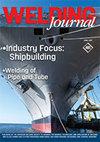Ductile Braze Repairs for Ni-Based Superalloys Using Novel MPEA Filler Metal
IF 1.4
3区 材料科学
Q2 METALLURGY & METALLURGICAL ENGINEERING
引用次数: 2
Abstract
The performance of a newly developed multiprincipal-element alloy (MPEA) filler metal for brazing of nickel-based superalloys was directly compared to a conventional boron- and silicon-suppressed filler (BSSF) metal. The comparison was demonstrated on an Alloy 600 substrate with a brazing temperature of 1200°C. Single-phase solidification behavior and the absence of boron and silicon in the MPEA led to a joint microstructure devoid of eutectic constituents or brittle phases in brazes employing this filler metal. In the brazes using the conventional BSSF metal, incomplete isothermal solidification and subsequent athermal solidification of the residual liquid resulted in large particles of a chromium-rich boride phase distributed throughout the microstructure. Tensile testing of brazed butt joints at both room temperature and 600°C testing conditions demonstrated that the MPEA joints exhibited total ductility values at least one order of magnitude greater than that of BSSF joints, but they showed comparable yield strengths in both testing conditions. Fractographic assessment confirmed that boride phases nucleated cracks and resulted in brittle failure in the BSSF joints, while the MPEA joints exhibited extensive ductile microvoid coalescence. Fine-scale porosity and oxide inclusions may be the dominant factors limiting the overall ductility observed in the MPEA brazes.新型MPEA填充金属钎焊修复镍基高温合金
对新研制的多元素合金(MPEA)钎料钎焊镍基高温合金的性能与传统的硼硅抑制钎料(BSSF)钎料进行了直接比较。在钎焊温度为1200°C的Alloy 600基板上进行了比较。单相凝固行为和MPEA中硼和硅的缺乏导致钎焊接头微观结构缺乏共晶成分或脆性相。在使用传统BSSF金属的钎焊中,残余液的不完全等温凝固和随后的非热凝固导致富铬硼化物相的大颗粒分布在整个组织中。在室温和600℃两种测试条件下,钎焊对接接头的拉伸测试表明,MPEA接头的总延性值至少比BSSF接头高一个数量级,但在两种测试条件下,它们的屈服强度相当。断口学评估证实,BSSF接头中硼化物相形成裂纹并导致脆性破坏,而MPEA接头则表现出广泛的延性微空洞合并。微观孔隙率和氧化物夹杂物可能是限制MPEA钎焊整体延展性的主要因素。
本文章由计算机程序翻译,如有差异,请以英文原文为准。
求助全文
约1分钟内获得全文
求助全文
来源期刊

Welding Journal
工程技术-冶金工程
CiteScore
3.00
自引率
0.00%
发文量
23
审稿时长
3 months
期刊介绍:
The Welding Journal has been published continually since 1922 — an unmatched link to all issues and advancements concerning metal fabrication and construction.
Each month the Welding Journal delivers news of the welding and metal fabricating industry. Stay informed on the latest products, trends, technology and events via in-depth articles, full-color photos and illustrations, and timely, cost-saving advice. Also featured are articles and supplements on related activities, such as testing and inspection, maintenance and repair, design, training, personal safety, and brazing and soldering.
 求助内容:
求助内容: 应助结果提醒方式:
应助结果提醒方式:


